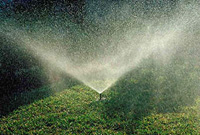 |
||
Ron’s ArticlesInvest Now - Save LaterJuly 2007
My pygmy goats control poison ivy on my property. It’s their favorite food, but they also eat plants other grazers avoid such as ragweed and fallen leaves. I was going to be away for a few days last month, so I pulled down some poison ivy that’s beyond their reach. They’re less than 2 feet tall. Poison ivy usually doesn’t affect me, so I took no precautions. I was in short sleeves and shorts with no gloves. Your plants will be healthier. You’ll provide safe harbor for beneficial insects, birds, bats and bees. They’ll keep harmful insects in check. If you plant citronella, lemon grass, lantana, even wild onions and wild garlic, you can rub the stems and blooms on your body as a natural insect repellant so you can enjoy yourself at your picnics. Of course, if you irrigate smartly and make sure that you don’t have any standing water, you can keep mosquitoes to a minimum. When I first moved into my home I was working on my landscape constantly. It had been over fertilized and over-watered. It took at lot of time and effort to convert it to organics. But now, when we have heavy rainfall my soil absorbs more of it. And even when there is runoff, my soil doesn’t wash away because I have a deep vigorous root system. My pond doesn’t silt up as badly, so I have more aquatic life. That means fewer mosquitoes because they gobble up the larvae. It’s one big harmonious circle. And, smart irrigation is a big factor. If you don’t have an irrigation system, get one. It’s almost impossible to water properly using hoses unless you have incredible amounts of free time. For an average lot, a system will run from $1,500 to $3,000 - most of which is labor. I strongly recommend that you have it installed by a licensed irrigation professional. Any plumber or laborer can dig a trench and glue PVC pipes together. But to have an effective system, you need to work with someone who understands the hydration needs of plants. Before signing a contract check the person’s license status with the Texas Commission on Environmental Quality at http://www.tceq.state.tx.us/nav/permits/licenses.html Plan your zones carefully to cover similar types of plantings - not simply the west side of the front yard. Use the best components you can afford. High quality heads hold up much longer and work better all the while. They aren’t made of that hard brittle plastic and the seals last longer. Don’t be afraid to mix components from different manufacturers. I may use products from five different sprinkler companies on a single job because they have different throw patterns or dimensions. No matter how well you plan your system, it won’t serve you well unless you use and maintain it properly. Learn how to program it based on local conditions. Never use AUTO unless you’re out of town. It’s pitiful to see sprinklers running during a rain - or shortly after. Not only is this wasteful, but it’s harmful. All that invigorating natural water is flushed away by chlorinated city water.
Check your system regularly - at least once a quarter. First, walk the property checking all the heads and looking for unusually moist areas. The heads should be about a half inch below the soil level. If they stick up, they can be hit by the mower and broken or twisted out of alignment. An unexplained moist area may be a sign of an underground leak. Then turn on each zone and walk through the spray. There’s no way to properly check you system without getting wet. Look for any signs of clogging or reduced or misdirected spray. Make sure you’re not watering sidewalks and patios. We have got to start making serious efforts to make the best use of our water. Water restrictions are going to be a fact of life. The simple truth is that we have twice as many people in this area than we had a decade ago. And there is no end in sight. Yet we’re still drawing upon the same limited water resources. I hope you take pleasure in many picnics in your beautifully maintained yard this summer. And think of me eating my favorite picnic fare - barbecued ribs. Enjoy! 
|
|
|


|
||

 Water only when needed - when your footprints remain after you walk across your lawn in the morning. Or, better yet, invest in a moisture meter. Normally, in the winter you only need ½ of water every other week. In the fall and spring you can get by with ¾ to an inch. But, in the heat of the summer, we can have periods where we need an inch and a half each week. Runoff is bad. Turn on each zone and note how many minutes it takes for runoff to start. Then program that zone to run for that time period. If you can’t reach the desired water amount in that time, rerun the program within an hour.
Water only when needed - when your footprints remain after you walk across your lawn in the morning. Or, better yet, invest in a moisture meter. Normally, in the winter you only need ½ of water every other week. In the fall and spring you can get by with ¾ to an inch. But, in the heat of the summer, we can have periods where we need an inch and a half each week. Runoff is bad. Turn on each zone and note how many minutes it takes for runoff to start. Then program that zone to run for that time period. If you can’t reach the desired water amount in that time, rerun the program within an hour.